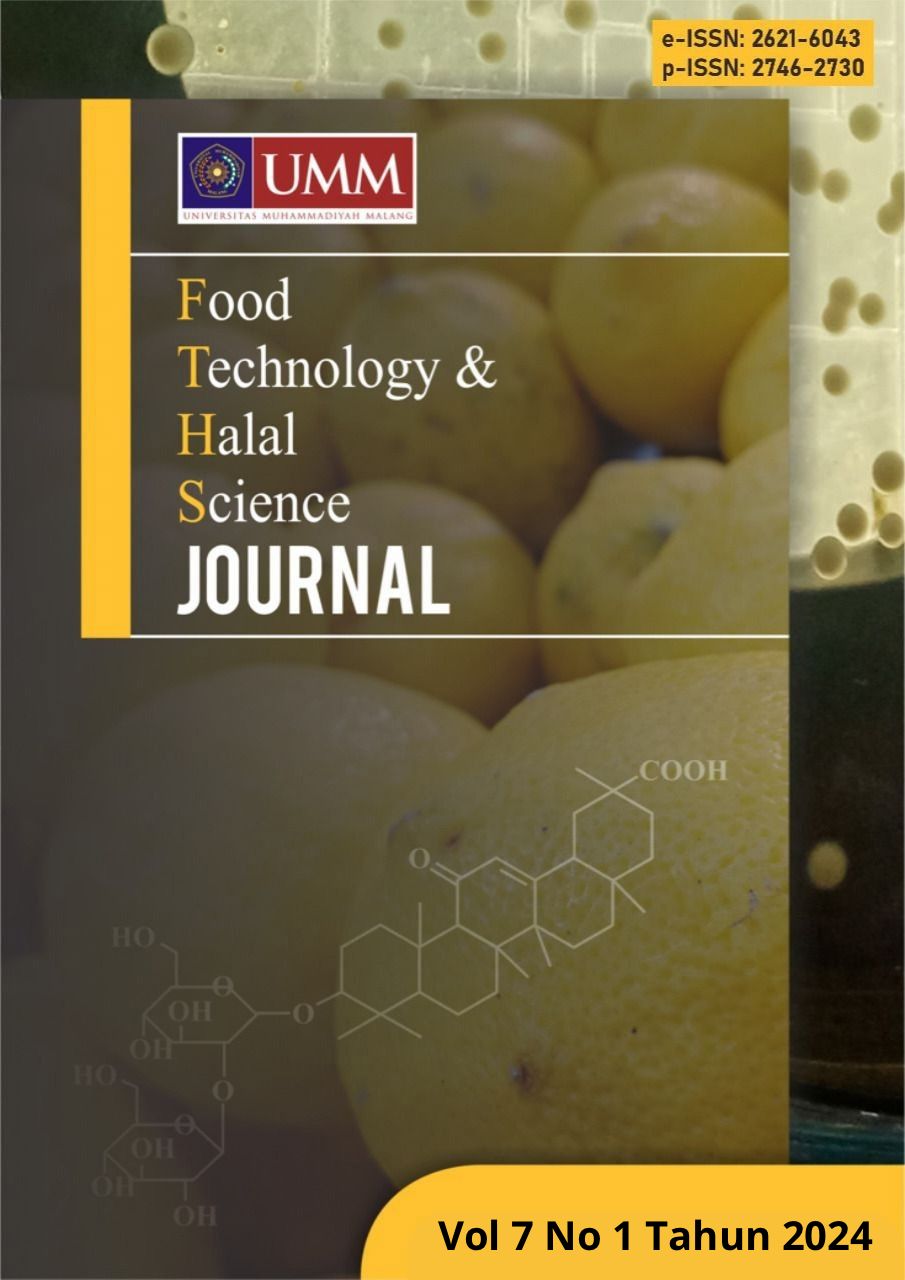Karakteristik Fisiko Kimia dan Organoleptik Bakso Vegetarian Berbasis Tempe Kacang Kedelai dan Kacang Merah (Phaseolus vulgaris L.)
DOI:
https://doi.org/10.22219/fths.v7i1.28527Keywords:
Meatballs, comparison, proteinsAbstract
Meatballs are one of the foods that are much liked by the people of Indonesia. Meatballs are generally made from meat, such as chicken, beef or fish. Vegetarians tend to consume meat analogues to replace animal flesh. Analog meat is usually made from legumes such as soybeans and red beans, where protein is an important nutrient needed by a vegetarian. Research using a simple randomized block design (RBD) with 7 treatment levels. The control treatment consisted of 50g of soybean flour and 50g of red bean flour. While the other 6 treatments used a comparison between soybean tempeh and red bean flour, namely 50:50; 55:45 ; 60:40 ; 65:35 ; 70:30 and 75:25. The results showed that the comparison of soybean tempeh and red bean flour had a significant effect on proximate levels (moisture content, ash content, fat content, protein content, carbohydrates), yield and meatball elasticity and had no significant effect on water holding capacity meatball. Treatment using 65g soybean tempeh and 35g red bean flour was the best treatment, with an average moisture content of 56.24%, ash content of 2.21%, fat content of 9.15%, protein content of 11.02%, carbohydrates 21.35%, water holding capacity 117.26%, yield 108.09%, elasticity 100.61gf, aroma 3.06 (rather like), color 3.06 (rather like), texture 3.33 (rather like) and taste 3.53 (towards like).
Downloads
References
Association of Official Analytical Chemist (AOAC). 2005. Official Methods of Analysis (18 Edn). Association of Official Analytical Chemist Inc. Mayland. USA.
Badan Standardisasi Nasional. 2014. SNI 01-3818-2014: Bakso Daging. Jakarta.
Faizah, Diah Nur. 2012. Substitusi Tepung Tempe pada Produk Beragi. Proyek Akhir. Universitas Negeri Yogyakarta. Yogyakarta.
Irawan, A.C., & N.Rahmawati. 2021. Pengaruh Penambahan Tepung Kacang Merah Terhadap Mutu Organoleptik, Fisik dan Kimia Nugget Ayam Kampung. Jurnal ilmiah vol.6(1).
Kristiningrum, E. and Susanto, D.A. 2015. Kemampuan Produsen Tempe Kedelai dalam Menerapkan SNI 3144 : 2009. Dalam Jurnal Standardisasi. 16 (2). Hal. 99–108.
Laksono, A. S., Marniza, & Rosalina, Y. 2019. Karakteristik Mutu Tempe Kedelai Lokal Varietas Anjasmoro dengan Variasi Lama Perebusan dan Penggunaan Jenis Pengemas. Jurnal Agroindustri, 9(1), 8–18.
Mentari, R., R.B.K. Anandito, dan B. Basito. 2016. Formulasi Daging Analog Berbentuk Bakso Berbahan Kacang Merah (phaseolus vulgaris) dan Kacang Kedelai (Glycine max). Jurnal Teknosains Pangan 5(3): 31-41.
Nuraidah. 2013. Studi Pembuatan Daging Tiruan dari Kacang Merah (Phaseolusvulgaris. L). Skripsi. Program Studi Ilmu Dan Teknologi Pangan Universitas Hasanudin. Maksssar.
Siregar, L.N.S., Harum, N., Rahmayuni. 2017. Pemanfaatan Tepung Kacang Merah Dan Salak Padang Sidimpuan (Salacca sumatrana R.) Dalam Pembuatan Snack Bar. JOM Faperta UR Vol.4 No.1
Taufik, Y., Nana S.A., Darin I.K.2018. Pengaruh Konsentrasi Bubur Buah dan Tepung Kedelai (Glycine max) Terhadap Karakteristik Fit Bar Black Mulberry (Morus nigra L). Pasundan Food Techology Journal. Volume 5 No.1.
Wipradnyadewi, P.A., Rahayu, E.S. & Sri, R. 2010. Isolasi dan Identifikasi Rhizopus oligosporus Pada Beberapa Inokulum Tempe.
Downloads
Published
How to Cite
Issue
Section
License
Copyright (c) 2024 Lissa Murni, Hanif Alamudin Manshur, Elfi Anis Sa’ati

This work is licensed under a Creative Commons Attribution 4.0 International License.
Authors who publish with this journal agree to the following terms:
- Authors retain copyright and grant the journal right of first publication with the work simultaneously licensed under a Creative Commons Attribution License that allows others to share the work with an acknowledgement of the work's authorship and initial publication in this journal.
- Authors are able to enter into separate, additional contractual arrangements for the non-exclusive distribution of the journal's published version of the work (e.g., post it to an institutional repository or publish it in a book), with an acknowledgement of its initial publication in this journal.
- Authors are permitted and encouraged to post their work online (e.g., in institutional repositories or on their website) prior to and during the submission process, as it can lead to productive exchanges, as well as earlier and greater citation of published work (See The Effect of Open Access).










